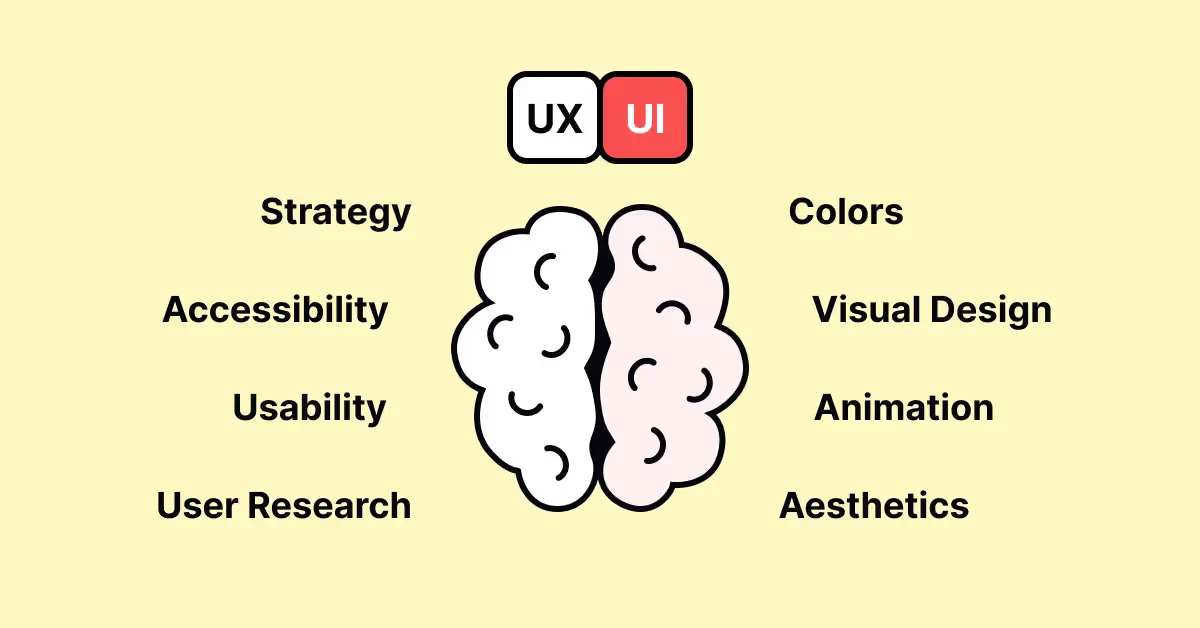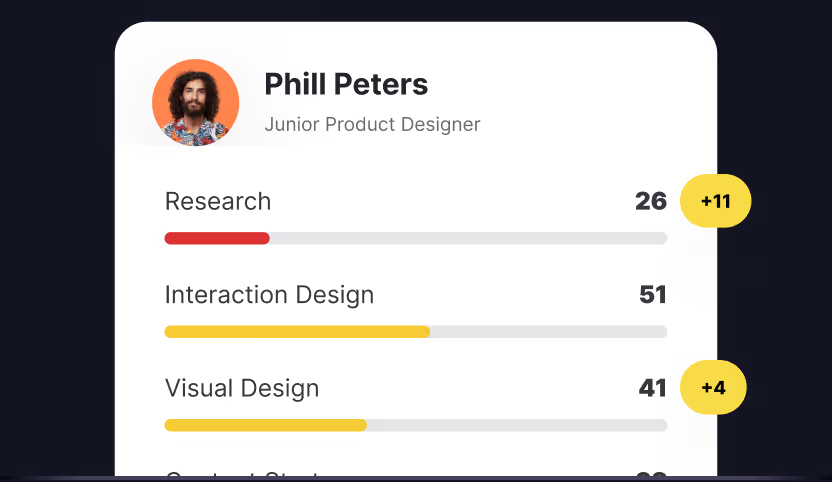
What’s the difference between UX and UI Design?
The terms "user experience (UX)" and "user interface (UI)" are frequently used interchangeably, even by designers. In fact, UX and UI design play similarly vital roles in product development but have different priorities and use different activities.
UI design is focused on the tangible elements of the interface — typography, color, icons, animations, and navigational components. It takes care of how user interfaces look and function.
According to the definition coined by cognitive scientist Don Norman, UX design represents all aspects of an end-user's interaction with the company, its services, and its products. You can't design a high-quality product without a deeper understanding of user behavior. Thus, user experience (UX) design is the process of designing products or services with users' interests and needs at heart.
According to the theory of Peter Morville, considered the founding father of information architecture, UX is a combination of 7 fundamental principles:
- Usefulness
- Desirability
- Accessibility
- Credibility
- Findability
- Usability
- Value-impact
UX design bridges the gap between the visual side of a product and its functionality and usability.
In other words, UI design refers to walls, windows, floors, stairs, furniture, and the whole interior aesthetics of a house. UX is more about the safety of the stairs, under-floor heating, the arrangement of rooms, the plumbing system, the neighborhood, and the overall experience of living in a house and how satisfying it feels.
Why is it important to know the difference?
Without understanding the value of user experience, your designs will be like art without meaning. Without UI, your designs are like an empty canvas without any story painted on it. If your product lacks good UX or UI, it won't achieve its business or user goals. They are both inseparable and cannot exist without each other. Learning UX and UI design at the same time and having both UI and UX designers on a team results in a more cohesive and transparent design process that leads to a better final product.
What is User Experience Design (UX)?
UX design refers to anything in life that creates an experience. It focuses on the interaction between people and products or services, whether that is a digital product, like a website or a mobile application, a theme park, or even a tea strainer.
The field combines elements of psychology, business, market research, design, and technology, requiring UX designers to wear multiple hats. It's so vast that it might include anything from facilitating a website's check-out process to exploring the impacts of brand colors on users' emotions or making an application easier to use in general.
.avif)
You could say that a UX design job requires marketing, design, and project management skills too. It is a complex role. Regardless of whether users interact with a car, an electric kettle, or a website, the main purpose of a UX designer is to create an easy and pleasant experience for users and meet business goals simultaneously.
Responsibilities of a UX Designer
Your first and foremost job as a UX designer is to bridge the gap between users, the development team, and key business stakeholders. You advocate for users and provide them with a delightful, accessible, and user-friendly user experience.
General UX designer responsibilities include:
User research
Best digital products are based on user research. User research helps UX designers understand and address user needs, pain points, motivations, and goals. A UX designer should be familiar with research methodologies and be able to conduct user interviews, surveys, focus groups, user testing, and other research activities. In addition, your job may also involve analyzing the findings of user studies, interpreting user feedback, and generating insights.
Once you conduct extensive user research and collect enough information about your target audience, it's time to create personas — a fictional yet realistic description of a typical or target user of the product. Personas help teams:
- Remember who their users are and what they want
- Develop empathy and understand pain points better
- Make better design decisions
Content strategy and information architecture
Information architecture is a part of the global content strategy that implies the planning, creation, and execution of all content available for users in a product or service. UX designers are mostly responsible for deciding what content (text, imagery, videos) a product needs and organizing it across pages in the most logical and approachable way.
Wireframing and prototyping
The UX design process often requires you to draft user flows and create wireframes and prototypes to map out user journeys throughout a product. User flows and wireframes help evaluate ideas, spot moments of friction, and optimize the user experience. Prototypes vary from paper models to high-fidelity interactive ones that visualize how the final product's interface will look and work. UX designers use them during user testing to identify design problems before the team wastes time and effort developing the final product. Testing might take several iterations and updates to wireframes before the design is approved.
Aside from these major responsibilities, UX designers can be involved in:
- Dealing with stakeholders and learning the specific domain
- Competitor analysis and market research
- Reviewing and providing feedback on designs
- Facilitating design workshops
- Tracking UX goals and metrics
Develop a deeper understanding of UX designer responsibilities and master the skills you'll need for this job by exploring UX design courses.
What is User Interface Design (UI)?
A UI designer's job description often resembles that of a graphic designer or visual designer. Although UI designers sometimes deal with branding and even front-end development, these tasks aren't part of their original role.
User interface design is a digital term. This is primarily where it differentiates itself from UX. UI stands for the interaction between users and a digital product or service. Simply put, it's what you see when interacting with a product. Examples include the touchscreen of an ATM machine or your smartwatch. UI also relates to the look and interactivity of desktop and mobile apps and websites. The UI design process focuses on visual, interactive elements (like buttons, menus, sliders, snackbars, icons, etc.), color theory, composition, and typography.
.avif)
UI design is not JUST about aesthetics. The main purpose of UI is to create visually appealing but also accessible, easy-to-use, consistent, and intuitive interfaces based on the insights about user behavior provided by UX design team.
Responsibilities of a UI Designer
A UI designer focuses on the physical implementation of the product vision. They create screens and visual elements that serve users when navigating a product.
Visual design
The visual aspect of a UI designer's job includes the design of all UI elements, such as:
- Buttons
- Inputs
- Cards
- Selection controls
- Date and time pickers
- Lists
- Modals
- Toasts
- Navigation bars
- Tabs, etc.
Creating and maintaining a design system is also a part of a UI designer's job. Design systems help a design team:
- Establish consistency across pages
- Simplify and speed up work
- Improve communication with the dev team and other designers
- Create a sense of familiarity and build users' trust in a product
Responsive design
Considering how an app or website will look on different devices and screens also falls under the responsibility of a UI designer. The best practices of the responsive design process include:
- Fluid grids and images
- Taking the mobile-first approach
- Aiming for minimalism
- Aiming for accessibility
- Following design patterns
- Using SVG images
Interaction design
The interaction design process requires UI designers to:
- Implement animation of elements
- Consider how interactive elements behave on a page (e.g., what happens when users click on a hamburger icon)
Branding
Maintaining a brand style guide and thinking about how to inject a product's personality into interfaces are tasks UI designers can perform together with visual designers. Aesthetics and consistency are two building blocks that help create a common visual language that makes a brand recognizable among users.
{Resource}
UX vs. UI — which is better for your business?
To fully push a product to completion, you cannot lack either UX or UI. UI design is about presentation and interactivity. UX design is, alternatively, an optimization, organization, and structuring of data. Without one or the other, a project cannot be completed. Despite this, the roles of a UI and UX designer are completely different with different tasks.

Typically, a UX designer maps out the entire user journey to solve one particular problem in the product. They focus on understanding users' problems and finding the best solutions. UX designers advocate for users and defend their interests when discussing design solutions with stakeholders. When hiring a UX designer, you should pay attention to their problem-solving skills, their design process, and how well they can articulate their UX case studies.
Alternatively, user interface designers consider all visual and interactive elements, from the first screen to the last screen and everything in between. A UI designer will make sure that the colors are suitable and typefaces are legible. Their goal is to set and apply the principles of accessibility and inclusion and make sure that a 65-year-old with visual impairments feels as comfortable as a 13-year-old using the same screen.
When hiring a UI designer, notice their attention to detail skills, wireframing and prototyping skills, as well as their knowledge of interaction design and responsive design process.
The responsibilities of UI and UX designers are closely interlaced, and we recommend you study them both if you're looking to secure your career path in the design industry. A UX/UI design course on Uxcel helps designers to master skills in these two areas in an easy and interactive way.
How UX and UI complement each other
UI and UX are inseparable. They complement each other, and both aim at increasing user satisfaction and enhancing the interaction between people and a product or service.
UI enhances a product's visual style, making it user-friendly, visually appealing, and memorable. On the other side, UX focuses more on the practicality of a product and ensures that it is solving user problems and making them feel satisfied with the entire experience.
UI/UX in Tech
The bottom line is that the difference between UX and UI is remarkable. Despite this, the tech industry has created a job title that encompasses both user experience and user interface design. It's a good idea to understand and improve both your UI & UX design skills together. It's common that in small companies, a user experience designer has a broad range of responsibilities and functions as a generalist who caters to all of the company's design needs, including visual design.
In larger companies, even though UX and UI have different meanings, different tools, and different contexts, they work hand in hand and have one goal — user satisfaction. In the tech industry, a product cannot exist without UX and UI, and thus the joint term UX/UI was born.
Learn more about UX and UI Design with Uxcel
Develop your UI and UX skills in a more structured way by enrolling in Uxcel's UX design courses. Understanding the difference between the two disciplines, we created the UX Design Foundations course that's focused on both UI and UX design skills you'll find listed in any job description of a UI/UX design position.
As a beginner, you might be interested in courses like Design Terminology, UI Components, or Design Patterns. For more advanced levels, Uxcel offers UX design courses in User Research, Wireframing, UX Writing, HTML, CSS, and other specific disciplines.




